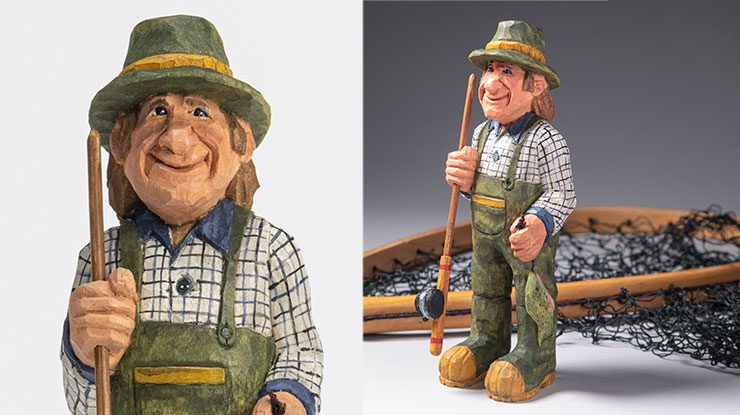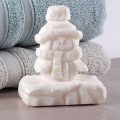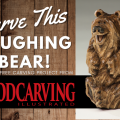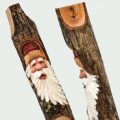Find in depth instructions on how to carve this happy caricature fisherman
By Jim Hiser
If you are looking for more detailed directions on how to carve Jim Hiser’s “Angling for Fun” project in our summer issue (#107), check out the step-by-step instructions below.
Step 2Refine the basic shape. With the carving knife, round the corners of the blank to make it easier to hold. Then start rounding the legs and boots. |
 |
Step 3Block in the head. Use the carving knife and 5/8″ (16mm) soft V-tool to start blocking in the face and hat. I like to work on these at the same time. |
 |
Step 5Shape the neck. Use the carving knife to create the neck area. Work back and forth on each side for symmetry. |
 |
Step 6Carve the nose. Use the carving knife to cut in the wings of the nose and the smile lines to start the mouth mound. Then set the angle of the nose. |
 |
TIP: GETTING NOSYTo carve the nostrils symmetrically, I draw a line across the nose, and then use that as a starting point. This way, there’s a good chance that both nostrils will be the same height. |
Step 8Add head details. Carve the ears and sideburns. Then use the 1/4″ (6mm) #9 gouge to carve the hair. |
 |
Adding DetailsStep 10Draw the clothing. Refer to the pattern to sketch the chest waders, pocket, and the shirt collar and sleeves. |
 |
|
MATERIALS • Wood, such as basswood, 2-1/2″ (6.4cm) square: fisherman, 6″ (15.2cm) long • Wood, such as basswood, 3/8″ (1cm) square: fish, 1-3/8″ (3.5cm) long • Wood, such as basswood, 3/8″ (1cm) square: reel, 1-3/4″ (4.4cm) long • Bamboo skewer: fishing pole, 3-1/4″ (8.3cm) long • Marker: black • Acrylic paint, such as Americana®: black, burnt sienna, dark forest, light buttermilk, tomato red, uniform blue; such as Anita’s™: chocolate brown; such as Ceramcoat®: coral, leaf green, medium flesh, silver, yellow ochre • Boiled linseed oil • Mineral spirits • Finish, such as spray lacquer • Glue: cyanoacrylate (CA), wood • Cord or string |
TOOLS • Carving knife • #5 gouge: 1/2″ (13mm) • #9 gouges: 1/8″ (3mm), 1/4″ (6mm) • V-tools: 1/8″ (3mm), 1/4″ (6mm) 60° • Soft V-tool: 5/8″ (16mm) • Drill with bit: 1/16″ (2mm)-dia. • Paintbrushes: assorted • Dish soap, such as Dawn® • Stiff brush |
| About the Author |
|
Jim Hiser lives in Carlisle, Pa. and started carving in 2000. He is a Member and Past President of the Caricature Carvers of America. He is also a member of the West Shore Woodcarvers and Lancaster County Wood Carvers. |
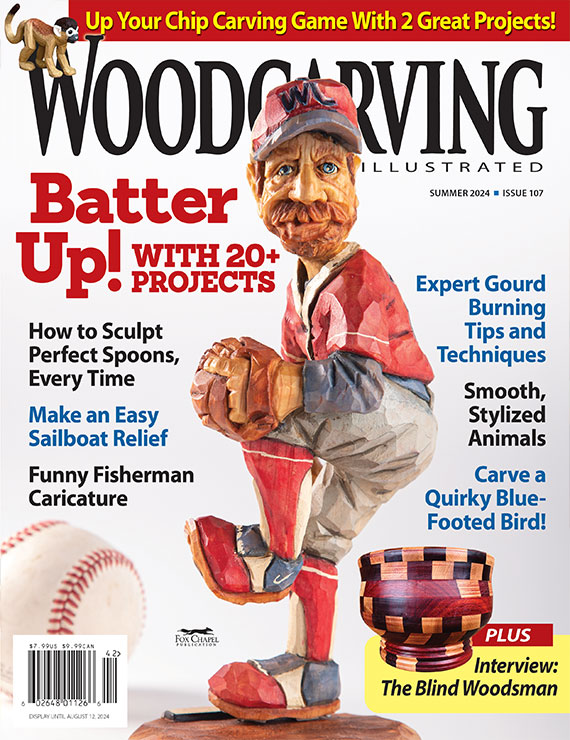 |
Get the Summer 2024 Issue Purchase the IssueFor more articles like this, subscribe to Woodcarving Illustrated magazine. Magazine SubscriptionPlus! Get digital mini magazines in your e-mail between printed issues.
|


